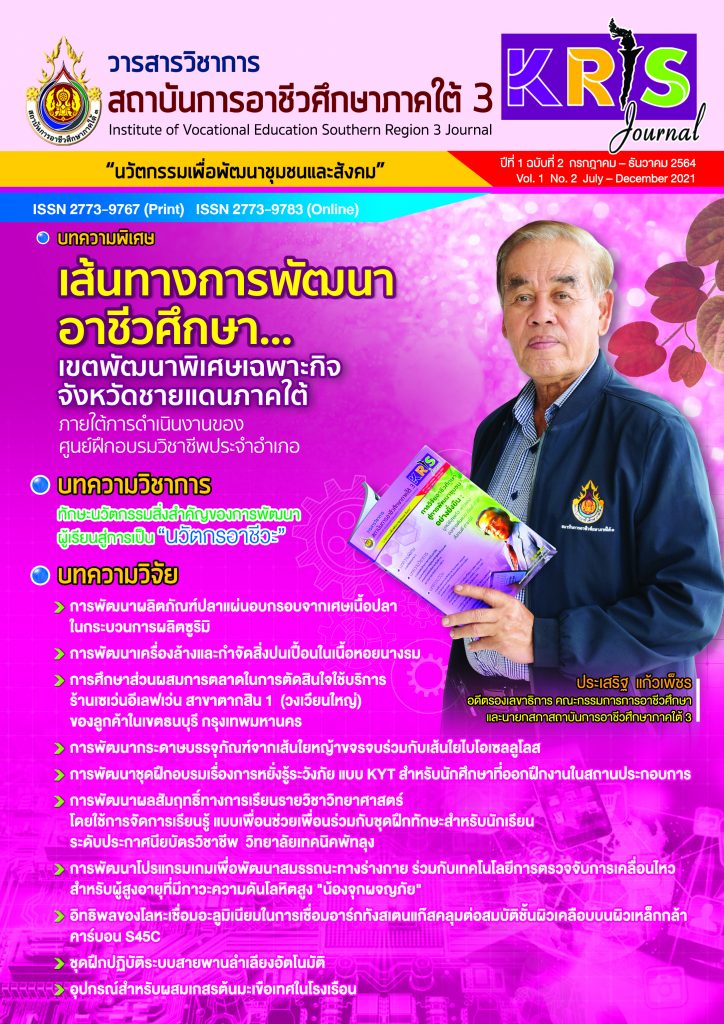Development of Crispy Fish Sheet from By-product Fish Fillet in Surimi Production Process
Keywords:
Crispy fish sheet, by-product fish fillets, SurimiAbstract
The development of crispy fish products from fish fillets in surimi production is the process of using minced fish scraps from the Surimi production process to convert into snacks with acceptable form and sensory. The objective of this research was to study the amount of wheat flour in crispy fish 4 levels, i.e. 0%, 1%, 2% and 3%, respectively. It is found that 3% wheat flour is a suitable formula accepted by consumers. This formula consists of a by-product fish fillets in surimi production process of 73.50%, tapioca starch 14%, wheat flour 3%, sugar 6%, salt 1.50%, soy sauce 2.50%, and pepper 1.50%. The results of physical analysis, color, brightness L *, a * and b * revealed the average of 41.36, 68.53 and 1.40, respectively. The color of the crispy fish products is dark red with slightly yellow and the average moisture content of 3.90%. The results of the study on the appropriate condiments in crispy fish products accepted by consumers included Laab, grilled squid, BBQ, and Tom Yum flavors with the most popular flavor was the grilled squid followed by Tom Yum, Laab, and BBQ respectively. The physical and lightness analysis of L * a * and b * of the crispy fish product showed the average results of 37.04, 70.50 and 9.22, respectively. Thecolor characteristicsof thecrispy fish products withtheadded condiments was dark red with slightly yellow. Finally, the results of chemical analysis of crispy fish products revealed that the moisture content in crispy fish products of Laab flavor, grilled squid flavor, BBQ flavor, and Tom Yum flavor had an average moisture content of 5.45%
References
กล้าณรงค์ ศรีรอต และเกื้อกูล ปิยะจอมขวัญ. (2543). เทคโนโลยีของแป้ง. พิมพ์ครั้งที่ 2. กรุงเทพฯ : สำนักพิมพ์มหาลัยวิทยาลัยเกษตรศาสตร์.
คณาจารย์วิชาวิทยาศาสตร์และเทคโนโลยีการอาหาร. (2546). วิทยาศาสตร์และเทคโนโลยีการอาหาร. พิมพ์ครั้งที่ 4. กรุงเทพฯ : มหาวิทยาลัยเกษตรศาสตร์.
จีรวรรณ มณีโรจน์และนันทิภา พันธุ์สวัสดิ์. (2555). การพัฒนาผลิตภัณฑ์ขนมขบเคี้ยวแบบแผ่นอบกรอบจากเศษเหลือปลาแซลมอน (รายงานผลการวิจัย). สำนักงานการวิจัยแห่งชาติ: กรงุเทพฯ.
มนตรี การะบัตร, พรรณพร ยืนยิ่ง และอนุธิดา ผายพันธุ์. (2552). ผลิตภัณฑ์ลานิลแผ่นปรุงรสเสริมใยอาหาร. ว.การเกษตรราชภัฎ. 8 (1), 33 - 45.
วันเพ็ญ มีสมญา, สมจิต อ่อนเหม, ศรุดา โลหะนะ, วันชัย วรวัฒนเมธีกุล และชมดาว สิกขะมณฑล. (2557). การศึกษาการผลิตปลาสวรรค์แผ่นฮาลาลจากปลาทะเล. สืบค้น 1 กันยายน 2564, สืบค้นจาก ku.ac.th/Conference/conference2014/proceedings/data/11_Science%20Tecnology1/11_Science%20Tecnology-1-2.pdf
สุทธวัฒน์ เบญจกุล. (2549). ซูริมิ. วิทยาศาสตร์และเทคโนโลยีเนื้อปลาบด. กรุงเทพฯ : สำนักพิมพ์โอเดียนสโตร์.
สำนักงานมาตรฐานผลิตภัณฑ์อุตสาหกรรม. (2553). มาตรฐานของผลิตภัณฑ์ชุมชนปลากรอบปรุงรสพร้อมบริโภค. สืบค้น 10 กันยายน 2564, สืบค้นจาก http://tcps.tisi.go.th/pub/tcps106_53.
Downloads
Published
How to Cite
Issue
Section
License
Copyright (c) 2024 Institute of Vocational Education Southern Region 3 Journal (KRIS Journal)

This work is licensed under a Creative Commons Attribution-NonCommercial-NoDerivatives 4.0 International License.






